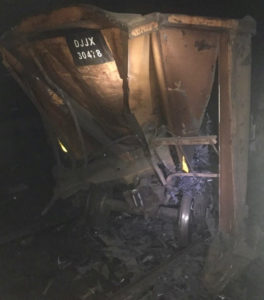
Canadian National, via Transportation Safety Board of Canada
The Transportation Safety Board of Canada reports it has issued four safety advisory letters during its ongoing investigation into a June 28, 2019, derailment of a Canadian National train in the St. Clair River tunnel connecting Sarnia, Ontario, and Port Huron, Mich.
In an investigation update issued Monday, the TSB reports 46 cars derailed in the train of three locomotives, one a mid-train distributed power unit, and 140 cars. The first car to derail appears to be the 53rd car, a bathtub gondola, in which the A-end appears to have collapsed, and analysis by both the TSB and U.S. National Transportation Safety Board determined the initial point of derailment occurred in Canada. Among the cars to derail was a tank car loaded with sulphuric acid, which was breached; most of its load of 12,000 gallons spilled in the tunnel.
The safety advisory letters include two issued in 2019 and two issued in September of this year. Those letters:
— Ask Transport Canada to ensure that railroads have instructions in their emergency procedures on how to inspect a train carrying hazardous materials after a derailment in a tunnel. In the June 28 incident, the conductor left the locomotive to inspect the train following the derailment per CN rules, and could not be reached by other crew members on the radio when those crewmen were informed that the tunnel’s toxic gas alarm had activated. Fortunately, no injuries occurred.
— Advise Transport Canada and the U.S. Federal Railroad Administration of potentially defective bathtub gondolas, and requests such cars — particularly those used in scrap metal service — should be inspected and, if needed, repaired.
— Ask that Transport Canada and the FRA to ensure that bathtub gondolas built by Berwick Forge are located and examined to ensure safe operation. It is estimated there may be 2,500 such cars in operation in North America.
— Advise Transport Canada to ensure all railroads have adequate practices in place to effectively manage in-train forces.
The derailment closed the tunnel for 11 days, leading to rerouting of CN trains on CSX Transportation tracks and an extensive backlog of traffic [see “Michigan-Ontario rail tunnel reopens after June derailment and acid spill,” Trains News Wire, July 10, 2019]









